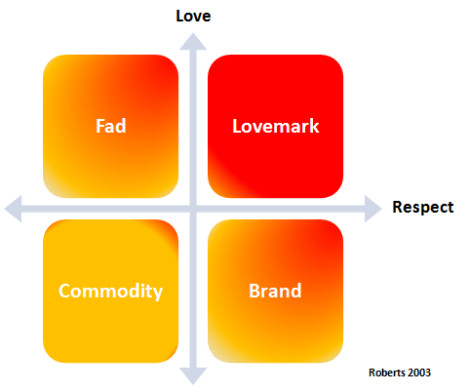The key to strong branding is ensuring that it sustains through the test of time. Branded products that rigidly hold on to their positioning, contrary to what one may believe, are not the ones that are most successful. Being rooted in your origins and true to what your identity is different from having the same associations and execution throughout generations. Branded products must connect with the consumers in such a way that they evoke both love and respect.
This is by far the best marketing matrix I have come across, for every product that I eat, use, see, feel and experience can easily fit into one of the categories. It identifies the crux of what I, as a consumer, will think about when using or consuming a product, and ignores other linguistic and technical jargon, by focusing only on my love and respect for it.
Most branded products fall high on the love, but only momentarily, or at most, for one generation. These are fads, which are aptly described as a craze for a brief period of time. Crocs, which are quickly languishing, or AOL Instant Messenger, are good examples. Fads have a short shelf life. True, they are created by the age-old principle to make hay while the sun shines, and if one is content with this, then it is an apt strategy.
Others ape the trends of the present generation, without differentiating themselves from competitors. The many celebrity colognes that flood the market, or better yet, the clothing brands we have, fall into this category; Express, Gap, you name it! [I do quite like some of these well defined brands, but as they say, my love is disloyal to most of them, despite my high respect for their competitive/vibrant/social-media-friendly advertising]. Brands tend to get lost in a competitive landscape, where they employ ancient strategies to offer slight differentiation, without any aptitude for risk or creativity. Whilst not as temporary as fads, they may not garner as much attention. Perhaps the archaic definition of trademark, or related negative associations of the word ‘brand’, are what contribute to this category being low on love and attachment.
Lets not talk about products who, in a perfectly competitive market, are equally substitutable, without offering any unique value proposition. These would be the reason that our grocery stores have entire aisles for things like pasta sauce, or cereal. Commodities, as the derogatory tinged word suggests, are simply that; perfectly substitutable products. Cost leaders will often lean towards this strategy.
The ones that retain themselves in our minds and lives are those which rise to more respectful levels than fads, and feel closer to our hearts than brands. These, as Roberts rightfully put it, are lovemarks. Despite the teasing compound word, it fits the emotional association of its meaning. I have bucket fulls of examples of these in my bedroom, bathroom, kitchen, and garage! But it’s not by coincidence that they make it to this stage. These must a) entail real value propositions, b) retain the core identity, and c) evolve brand positioning to keep up with evolving trends and demographics, as I believe that these are the three primary principles to create lovemarks.
There is an element of cyclicality that I would like to suggest to this matrix. For instance, over time, a fad may become a commodity, or if its execution becomes more apt, it may become a brand. And with the right promotion and product mix, it could become a lovemark. Similarly, lovemarks could topple down as brands without sustained interest. So, in addition to fulfilling the aforementioned three principles, branded products must consistently race on a treadmill, which in turn is on a slippery slope.
Welcome to the world of branding!



Pingback: The Cyclicality of Denim Jeans: Part 2 « Food, Fashion & Frameworks·
Pingback: Bite by Bite, Seduction by Cookies « Food, Fashion & Frameworks·
Pingback: I Want to Eat the In-Edible: Part 1 « Food, Fashion & Frameworks·
Pingback: I Want to Eat the In-Edible: Part 2 « Food, Fashion & Frameworks·
Pingback: Denim is Dead. Long Live Denim. « Food, Fashion & Frameworks·
Pingback: Where’s my ice cream AGAIN, mommy? « Food, Fashion & Frameworks·
Pingback: 10 Habits of Stylish Guys: Upgraded and Evolution-ized « Food, Fashion & Frameworks·
Pingback: Denim Is Dead (Distressed?) . Long Live Denim·
Pingback: Cyclic Trends In Denim Jeans·
Pingback: Shopper Psychology and Retailer Strategy « Food, Fashion & Frameworks·
Pingback: What to wear with what you are wearing |·
Pingback: The Food Forecast of 2014: 11 Tasty Trends |·
Pingback: Weather Essentials with Nautica and Todd Snyder at NYFWM | 3FS: Food Fashion Frameworks·